Early Assessment and Management of Trauma
Trauma is the leading cause of morbidity and mortality in children from ages 1 to 14 years. It results in more disability and death than all other childhood diseases combined.1 More than 10,000 pediatric patients die from trauma in the USA each year.1 Approximately 10% of pediatric hospitalizations,2 15% of pediatric intensive care unit (PICU) admissions,3 25% of pediatric emergency department visits,4 and 50% or more of pediatric ambulance runs are due to trauma.5 Moreover, it also represents nearly 20% of hospitalizations for serious injury among all age groups combined.6
Trauma Epidemiology
Several injury severity scales exist in practice and in the literature. The large number of injury severity scales arises from the markedly different perspectives used in the application of the scales. The Abbreviated Injury Scale (AIS), primarily an anatomical measure of injury severity, was the first widely implemented scale used in practice. Criticism of the AIS included the inability to take into account multiple injuries to the same body region and the poor correlation of the AIS with severity and survival. The Injury Severity Score (ISS), New Injury Severity Score (NISS) and Pediatric Trauma Score (PTS) are just some examples of scoring systems developed to overcome the issues described. Despite the controversies in these scales, it is commonly accepted that injuries whose severity are a threat to life correspond to an ISS of 10 or higher, or a PTS of 8 or lower.2
The incidence of serious traumatic injury is approximately 420/100,000.7 Although the hospital-based fatality rate is 2.4/100,000, the population-based mortality rate is 11.8/100,000, indicating that 78% of lethally injured children die before hospital admission and demonstrating the need for effective injury prevention and prehospital care.8
Blunt injuries outnumber penetrating injuries in children by a ratio of 12 : 1, a ratio that has decreased somewhat in recent years. While blunt injuries are more common, penetrating injuries are more lethal. However, despite the decline in penetrating injuries, firearm related deaths continue as one of the top three causes of death in the American youth. Most blunt trauma in childhood is sustained unintentionally, but between 5–10% of serious injuries are due to intentional physical assault (of which half are due to physical abuse).9 Still, the leading cause of death in children is the motor vehicle, responsible for approximately 75% of all childhood deaths, which are evenly split between those due to pedestrian trauma and those resulting from occupant injuries (Table 14-1).
TABLE 14-1
Incidence and Mortality from the Major Categories of Pediatric Trauma
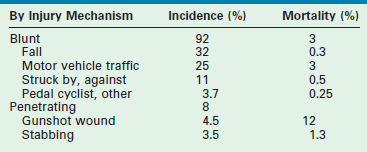
Data from the American College of Surgeons, National Trauma Data Bank 2012.
Injury Risks
The lack of adequate supervision of children during play involving possible injury hazards is recognized as a major risk factor for unintentional injury in pediatric patients. However, drug and alcohol use, obesity, poverty, and race also influence injury frequency. Toxicology screens are reportedly positive in 10–40% of injured adolescents, while obese children and adolescents appear to have more complications and require longer stays in the intensive care unit.10–13 Socioeconomic status has also been associated with increased hospitalization and mortality following major trauma, owing to a higher frequency and more lethal mechanisms of injury, rather than injury severity.14 Race and ethnicity affect injury risk independent of socioeconomic status, particularly among African-American children, whose rate of death from preventable injuries, head injuries, and child abuse is three to six times higher than that of white children.15–18 Improper use of restraints may contribute to the increased fatality rates observed in African-American children, who are half as likely to be restrained as white children when involved in motor vehicle crashes (MVCs) and one-third as likely to be placed in car seats during MVCs.19
Analysis of the Crash Injury Research Engineering Network (CIREN) database has recently yielded valuable information about the pattern of childhood injuries after MVCs: (1) child victims in frontal crashes are more likely to suffer severe spine and musculoskeletal injuries; (2) those in lateral crashes are more likely to suffer head and chest injuries; (3) those in front seats sustain more injuries to the chest, abdomen, pelvis, and axial skeleton than those in the rear seats; (4) seat belts are especially protective against pelvic and musculoskeletal injuries; (5) children involved in high-severity, lateral-impact crashes typically sustain injuries characterized by higher ISS and lower Glasgow Coma Scale (GCS) scores.20,21 Restraint devices have also been subjected to careful analysis in recent years: (1) they do not appear to protect young victims of MVCs as well as older victims; (2) car seats may not significantly affect injury outcome; (3) improper application may predispose to abdominal injuries, even in low-severity crashes; (4) the presence of abdominal wall bruising in restrained children, although not commonly observed, is frequently indicative of intra-abdominal injury.22–27
Injury Outcomes
In recent years, much effort has been devoted to outcomes research in pediatric trauma with the hope that benchmarking of treatment results may lead to better care for injured children. Both historical studies and contemporary investigations indicate that children survive more frequently and recover more fully in hospitals that specialize in pediatric trauma than in other hospitals.28–45 No less important than survival outcome is functional outcome, for which numerous studies now indicate improved outcomes in hospitals that specialize in pediatric trauma care.32–46 However, these studies also suggest that whereas children may recover from injury more quickly than adults, physical function may not fully normalize. Even so, self-perceived long-term quality of life among seriously injured children may not be adversely affected, justifying an aggressive approach to their resuscitation.47
Perhaps the most important recent development for outcomes research in pediatric trauma has been the expansion of the National Trauma Data BankTM (NTDBTM) of the American College of Surgeons (ACS) to include children. Initially designed as a simple case repository, efforts continue to analyze submitted cases to provide population estimates of severe pediatric injury and develop quality benchmarks for pediatric trauma care. Preliminary data suggest that these benchmarks perform as well as existing measures.48
Injury Prevention
Injuries are not accidents, but rather predictable events that respond to harm-reduction strategies similar to those applied for other diseases. The Haddon Factor Phase Matrix neatly depicts these in graphic form (Fig. 14-1).49 Strategies to lessen the burden of injury are applied to the host, agent, and environment before, during, and after the traumatic event using enforcement, engineering, education, and economics as techniques to limit the adverse impact of each factor.

FIGURE 14-1 The Haddon Factor Phase Matrix, as modified and refined to include a third strategic dimension, integrates all phases of injury control into a single system. (Adapted from Haddon W. Advances in the epidemiology of injuries as a basis for public policy. Public Health Rep 1980;95:411–21; and Runyan CW. Using the Haddon Matrix: Introducing the third dimension. Inj Prev 1998;4:302–7.)
Effective injury-prevention programs are community-based and require extensive collaboration with civic leaders, governmental agencies, community-based organizations, and neighborhood coalitions. Programs such as the National Safe Kids Campaign (http://www.safekids.org) and the Injury Free Coalition for Kids (http://www.injuryfree.org) have proven highly successful in reducing the burden of childhood injury in many communities.
Injury Patterns
Injury mechanism is the main predictor of injury pattern. The body regions most frequently injured in major childhood trauma are the lower extremities, head and neck, and abdomen. In minor childhood injury, soft tissue and upper extremity injuries predominate. Motor vehicle versus pedestrian trauma results in the Waddell triad of injuries to the head, torso, and lower extremity (pelvis, femur, or tibia; Fig. 14-2). Motor vehicle accidents may cause head, face, and neck injuries in unrestrained passengers. Cervical spine injuries, bowel disruption or hematoma, and Chance fractures occur in restrained passengers (Fig. 14-3). Bicycle trauma results in head injury in the unhelmeted riders as well as upper extremity and upper abdominal injuries, the latter the result of contact with the handlebar (Fig. 14-4 and Table 14-2). Direct impact from a bicycle handlebar remains highly predictive of the need for operation.27
TABLE 14-2
Common Injury Mechanisms and Corresponding Injury Patterns in Childhood Trauma
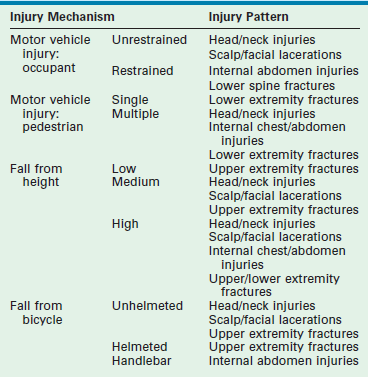
From American College of Surgeons Committee on Trauma. Advanced Trauma Life Support® ATLS® Student Course Manual. 9th ed. Chicago: American College of Surgeons; 2012.
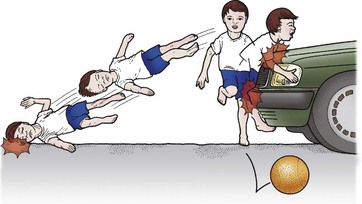
FIGURE 14-2 The Waddell triad of injuries to head, torso, and lower extremity is depicted. (From Foltin G, Tunik M, Cooper A, et al, editors. Teaching Resource for Instructors of Prehospital Pediatrics. New York: Center for Pediatric Emergency Medicine; 1998. Accessed at http://www.cpem.org.)

FIGURE 14-3 The mechanism for the development of intestinal and vertebral injuries from lap belts is shown. (From Foltin G, Tunik M, Cooper A, et al, editors. Teaching Resource for Instructors of Prehospital Pediatrics. New York: Center for Pediatric Emergency Medicine; 1998. Accessed at http://www.cpem.org.)
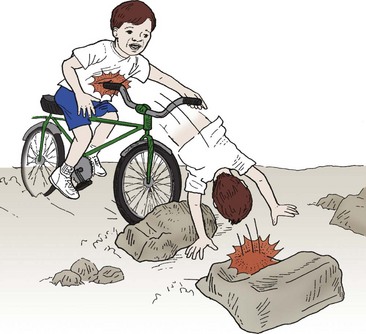
FIGURE 14-4 Children riding bicycles can sustain blunt abdominal trauma after contact with handlebars or head trauma from falling off the bicycle. (From Foltin G, Tunik M, Cooper A, et al, editors. Teaching Resource for Instructors of Prehospital Pediatrics. New York: Center for Pediatric Emergency Medicine; 1998.)
Head
Head injuries are potentially more dangerous in children than in adults for several reasons. First, developing neural tissue is delicate and the softer bones of the pediatric skull allow impact forces to be transmitted directly to the underlying brain, especially at points of bony contact. Second, intracranial bleeding in infants in whom the fontanelles and sutures remain open may, on rare occasions, be severe enough to cause hypotensive shock. Third, the proportionately larger size of the head, when coupled with the injury mechanisms commonly observed in children, generally leads to head trauma with a loss of consciousness. As a consequence, the voluntary muscles of the neck lose their tone which can lead to soft tissue obstruction in the upper airway and hypoxia. Hypoxia exacerbates and potentiates the initial traumatic injury to the brain (secondary insults). See Chapter 17 for more information about head injuries.
Neck
Cervical spine injury is a relatively uncommon event in pediatric trauma. It affects approximately 1.5% of all seriously injured children, and occurs at a rate of 1.8/100,000 population, in contrast to closed-head injury, which occurs at a rate of 185/100,000 population.50–52 The pediatric surgeon should also be aware of normal variants of cervical spine anatomy. The greater elasticity of the interspinous ligaments and the more horizontal apposition of the cervical vertebrae also give rise to a normal anatomic variant known as pseudosubluxation, which affects up to 40% of children younger than age 7 years. The most common finding is a short (2–3 mm) anterior displacement of C2 on C3, although anterior displacement of C3 on C4 also may occur. This pseudosubluxation is accentuated when the pediatric patient is placed in a supine position, which forces the cervical spine of the young child into mild flexion because of the forward displacement of the head by the more prominent occiput. The greater elasticity of the interspinous ligaments also is responsible for the increased distance between the dens and the anterior arch of C1 that is found in up to 20% of children.
When an injury to the cervical spine does occur, it frequently occurs at C2, C1, and the occipitoatlantal junction. The injuries are above the nerve roots that give rise to diaphragmatic innervation (C4) and predispose the afflicted child to respiratory arrest as well as paralysis. The increased angular momentum produced by movement of the proportionately larger head, the greater elasticity of the interspinous ligaments, and the more horizontal apposition of the cervical vertebrae are responsible for this spectrum of injuries. Subluxation without dislocation may cause spinal cord injury without radiographic abnormalities (SCIWORA). SCIWORA accounts for up to 20% of pediatric spinal cord injuries as well as a number of prehospital deaths that were previously attributed to head trauma.53–55
Chest
Serious intrathoracic injuries occur in 6% of pediatric blunt trauma victims.56 Although thoracostomy is required in about 50%, thoracotomy is seldom needed. Lung injuries, pneumothorax and hemothorax, and rib and sternal fractures occur most frequently (Table 14-3). Injuries to the heart, diaphragm, great vessels, bronchi, and esophagus occur less frequently, but have higher mortality rates associated with them. Because blunt trauma is nearly ten times more deadly when associated with major intrathoracic injury, thoracic injury serves as a marker of injury severity, even though it is the proximate cause of death in less than 1% of all pediatric blunt trauma.57
TABLE 14-3
Incidence and Mortality of Injuries to Thoracic and Abdominal Organs
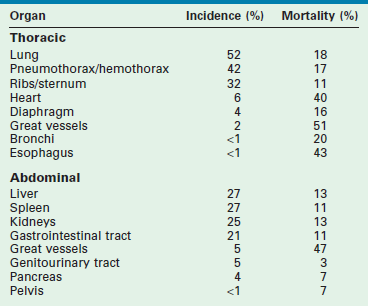
From Cooper A, Barlow B, DiScala C, et al. Mortality and truncal injury: The pediatric perspective. J Pediatric Surg 1994;29:33–8.
Abdomen
Serious intra-abdominal injuries occur in 8% of pediatric blunt trauma victims and are caused by crushing the solid upper abdominal viscera against the vertebral column, sudden compression and bursting of the hollow upper abdominal viscera against the vertebral column, or shearing of the posterior attachments, including the vascular supply, of the upper abdominal viscera after rapid deceleration (see Table 14-3).56,58 Injuries to the liver (27%), spleen (27%), kidneys (25%), and gastrointestinal tract (21%) occur most frequently and account for most of the deaths from intra-abdominal injury. Injuries to the great vessels (5%), genitourinary tract (5%), pancreas (4%), and pelvis (<1%) occur less frequently and account for few of the deaths that result from intra-abdominal injury. Most solid visceral injuries are successfully managed nonoperatively, especially those involving the kidneys (98%), the spleen (95%), and the liver (90%).59–61
Skeleton
Although they are the leading cause of disability, fractures are rarely an immediate cause of death from blunt trauma. They are reported to occur in 26% of serious blunt-injury cases and constitute the principal anatomic diagnosis in 22%.9 Upper extremity fractures outnumber lower extremity fractures by 7 : 1, although, in serious blunt trauma, this ratio is 2 : 3. The most common long bone fractures sustained during pedestrian/MVCs in children are fractures of the femur and tibia. Falls are typically associated with both upper and lower extremity fractures if the fall height is significant (from the window of a high-rise dwelling or the top of a bunk bed, but not from falls from standard beds or down stairs).62–65 Because isolated long bone and stable pelvic fractures are infrequently associated with significant hemorrhage, a diligent search must be made for another source of bleeding if signs of shock are observed.66,67 Unstable pelvic fractures are an uncommon feature of childhood injury, but unilateral (type III) or bilateral (type IV) anterior and posterior disruptions are those most often associated with major hemorrhage and must be recognized early and treated.68
Prehospital Care
Basic life support for the pediatric trauma patient consists of oxygen administration, airway adjuncts, bleeding control, spine stabilization, and temperature maintenance. Assisted ventilation and fracture immobilization should be provided as needed. Spinal immobilization requires both neutral positioning (which cannot be achieved without placing an approximate 2.5 cm layer of padding beneath the torso from shoulders to hips) and careful strapping (because forced vital capacity may be decreased by up to 60%).69,70 One study suggested that cervical spine immobilization can be safely avoided in most pediatric trauma patients with minor injuries, but caution was urged in view of the known risks of SCIWORA and atlanto-axial instability.71 Advanced life support of the pediatric trauma patient theoretically adds endotracheal intubation and volume resuscitation to this armamentarium, but neither intervention has been shown to improve outcome.72–76
Field triage of pediatric trauma patients to pediatric trauma centers is now well established. Regional protocols should direct ambulance transports to such centers where available. The use of scoring systems to assist in predicting the need for specialty pediatric trauma care, such as the PTS and the Revised Trauma Score (RTS), may reliably predict the need for specialty pediatric trauma care but neither is optimally sensitive nor specific (Table 14-4).77,78 The most sensitive and specific indicators for the need for specialty pediatric trauma care are: a score of 1 in best motor response in the calculation of the GCS or a selection of ‘unresponsive/unconscious’ in the calculation of an AVPU Score.79 Good results also have been achieved by using checklists to identify anatomic, physiologic, and mechanistic criteria (Box 14-1) rather than calculated scores. These checklists are currently advocated by the ACS Committee on Trauma, based upon the advice of an expert panel convened in 2011 by the United States Centers for Disease Control and Prevention (CDC).80
Emergency Care
Primary Survey
Early management of childhood trauma begins in the field and continues in the emergency department.81,82 A primary survey of the airway, breathing, circulation (see Box 14-1) and neurologic disabilities (Box 14-2) should be completed to identify and correct deficits that pose an immediate threat to life. The primary survey continues with complete exposure of the patient to ensure that no injuries are missed, taking care to avoid hypothermia. The placement of therapeutic adjuncts, such as a urinary and gastric catheter (unless contraindicated), is also completed during this initial survey. Diagnostic adjuncts, such as pulse oximetry, radiographs, and focused assessment by sonography in trauma (FAST), facilitate the early recognition and treatment of immediate threats to vital functions (Box 14-3). The complete ‘trauma series’ of radiographs obtained as an adjunct to the primary survey in adults may not always be necessary in children, since the lateral cervical spine radiograph will not detect SCIWORA, and the screening pelvic radiograph seldom identifies a pelvic fracture. If a pelvic fracture is suspected on physical examination, a computed tomography (CT) scan should be obtained.83,84






